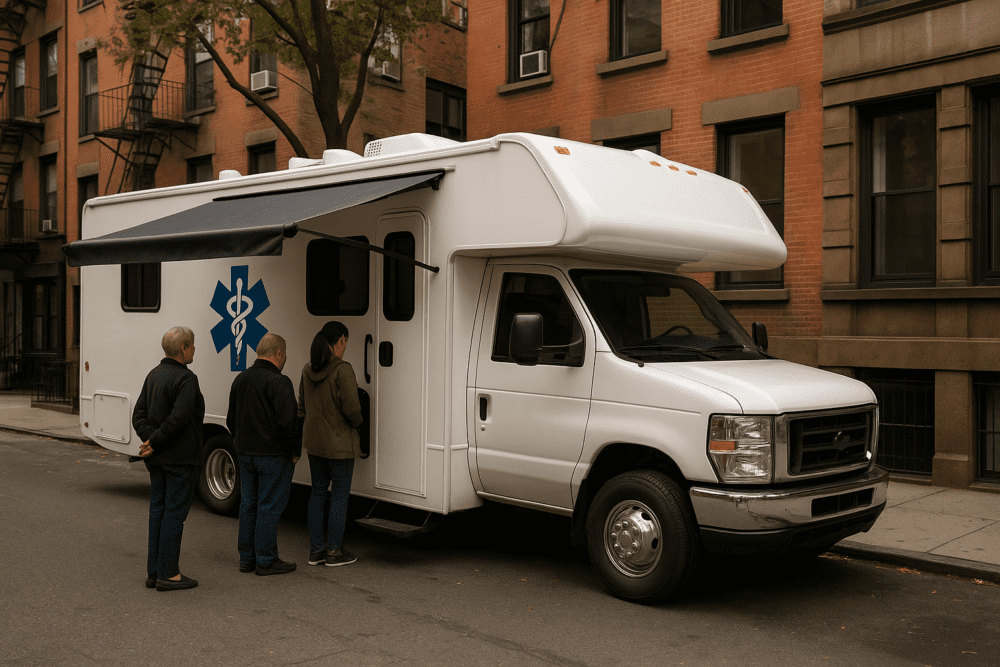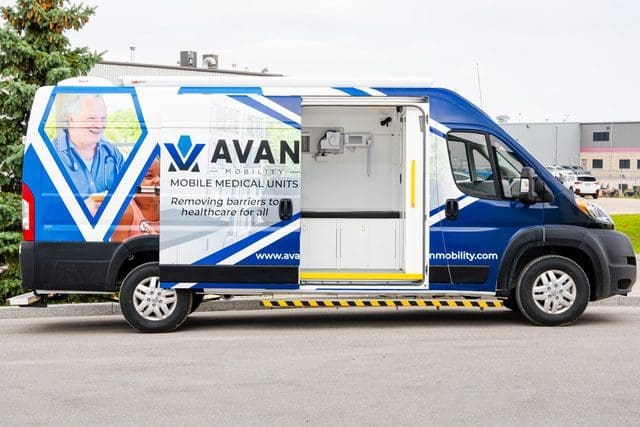Over 3.5 million people in Illinois live in areas with too few primary care providers. That’s a lot of people stuck without the healthcare they need.
If your organization is looking into mobile clinics, chances are you’ve seen this problem up close. Maybe you run a health center, a nonprofit, or work in public health. You’re trying to bring care to people who can’t always get to a clinic. But now you’re wondering…
“What is the cost of a mobile clinic in Illinois?”
That’s a big question. And it’s normal to feel stuck. You don’t want to waste money. You don’t want to choose the wrong setup. And you definitely don’t want to end up with something that doesn’t do the job.
Waiting too long means:
- People stay sick or skip care
- ER visits go up
- You miss a chance to make a real difference
But with the right mobile clinic, you can close that gap. You can meet people where they are. And you can do it on your terms.
At AVAN Mobility, we’ve been building mobile medical units for over 10 years, helping organizations across the U.S.—including right here in Illinois. And while we build these vehicles, this article isn’t a sales pitch. It’s here to help you figure out what really affects the cost of a mobile clinic in Illinois—plain and simple.
Let’s dig into what you need to know. Keep in mind that all prices mentioned in this article are just estimates, can vary, and are subject to change.
How much does a mobile clinic in Illinois cost?
So, let’s talk numbers. The cost of a mobile clinic in Illinois usually falls somewhere between $125,000 and $225,000.
We realize it’s a big range—and there’s a reason for that.
Some clinics are simple and focused on basic checkups. Others are built for more advanced care, like mobile dental care, mobile mental health, or even mobile OBGYN. That means prices can go up or down depending on what your team needs.
But don’t worry—you’re not expected to figure this all out on your own. You’re here to learn, and that’s a smart place to start.
Here’s a quick breakdown:
- $125,000–$150,000: Entry-level mobile clinics with the essentials
- $150,000–$200,000: Mid-range units with more features and flexibility
- $200,000–$225,000: High-functioning units for specialized care
These numbers give you a ballpark idea of what to plan for. But there’s more to the story.
In the next section, we’ll discuss the biggest factors affecting the cost of a mobile clinic in Illinois so you can make choices that fit your needs and your budget.
What features affect the cost of a mobile clinic in Illinois?
Now that you know about the cost range you can expect for a mobile clinic, let’s take a look at some of the customization features that add to your price. We’ll also highlight a few extra fees you can expect.
Awning: $5,000
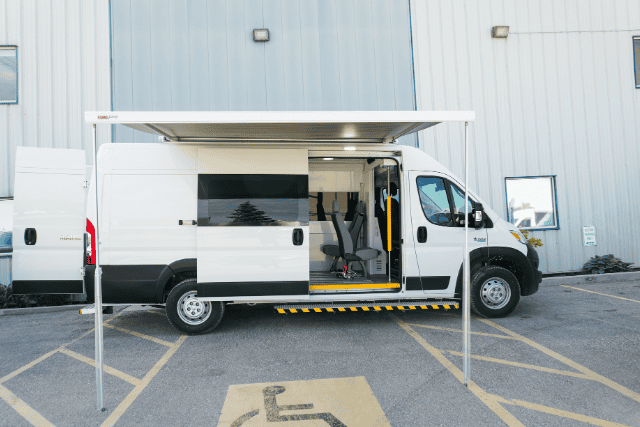
Let’s talk about awnings—that simple feature that might not seem like a big deal… until you don’t have one.
Adding an awning to your mobile clinic costs around $5,000. At first glance, that might feel like a lot for something that just provides shade. But in real use, it does way more than that—especially in Illinois.
Here’s why it matters:
Weather protection: Illinois weather is all over the place. From hot, sunny days to surprise rainstorms, an awning gives your patients and staff cover when they’re waiting or setting up outside.
Better patient flow: If your clinic offers walk-up service, an awning creates a natural waiting area. That helps keep things organized and makes the space feel more welcoming.
More flexibility: You can run things like registration, screenings, or check-ins outside the vehicle when the weather allows.
Think of it like an outdoor lobby. It extends your usable space without needing a bigger unit.
Illinois sees everything from snow in April to 90°F heat in September. That awning? It helps you roll with it.
Window tint and cabinet locks: $2,000
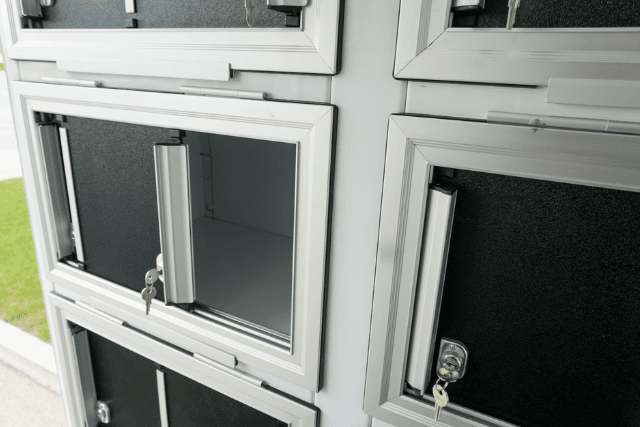
Here’s an easy-to-overlook detail that plays a big role in keeping your mobile clinic safe and secure: tinted windows and locks on medicine cabinets. The cost? Around $2,000.
It sounds small compared to the full clinic price, but this feature packs a punch—especially if your clinic will store medications or medical supplies.
Here’s what this upgrade does for you:
Keeps medications hidden: Tinted windows make it harder for people to see what’s inside. That helps prevent theft and adds privacy.
Protects from sunlight: Some medications and equipment can be sensitive to heat and sunlight. Tinting helps block UV rays, especially during those long, bright Illinois summers.
Locking cabinets add another layer of security. Depending on your clinic’s licensing, this is often a requirement for regulatory compliance, keeping controlled substances, vaccines, and other medications safe.
In Illinois, where your unit might be parked in high-traffic areas or rural settings with little oversight, this upgrade is a smart move. It protects both your supplies and your staff.
Extra windows: $2,000
Thinking about adding a few extra windows to your mobile clinic? Each one will run you about $2,000.
That might seem like a lot just to let in more sunlight. But depending on how your team works—and where you’re setting up in Illinois—it could be a smart investment.
Why some clinics add extra windows:
More natural light: It makes the space feel bigger, calmer, and more welcoming for patients. This can be especially helpful for mental health units or pediatric care, where comfort matters.
Better visibility: If your team is moving between different workstations, extra windows can improve overall visibility inside the unit.
Patient comfort: Natural light helps people feel more at ease, which can be helpful for screenings, checkups, or education-based visits.
Medical equipment: $2,500 – $75,000
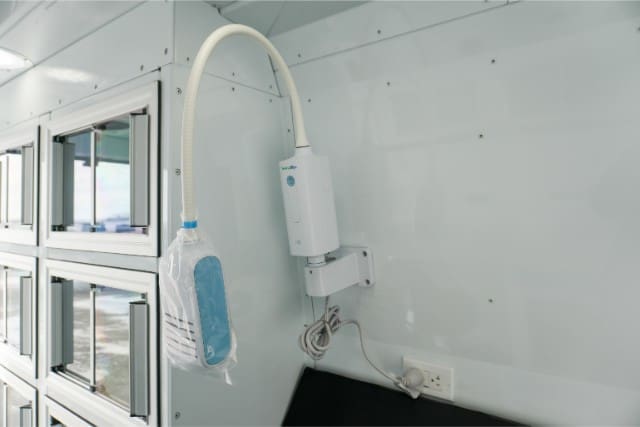
Let’s discuss the biggest price range for mobile clinics so far: medical equipment. Depending on your clinic’s needs, costs can start around $2,500 for basic diagnostic tools and climb up to $75,000 for advanced machines like portable X-rays.
That’s a huge gap. But it makes sense when you look at what you’re trying to do—and where you’re doing it.
In Illinois, especially in rural counties and underserved urban areas, people often can’t get to a doctor for even the most basic care. Some counties don’t have a single hospital, and others are dealing with long wait times and overworked providers.
Here are some cost ranges to keep in mind:
Mini diagnostics ($2,500–$10,000): Think blood pressure monitors, glucose meters, pulse oximeters. These are great for checkups, chronic condition monitoring, or school-based visits.
Mid-range equipment ($10,000–$30,000): EKGs, autoclaves, or point-of-care lab tools. These help your clinic do more on-site, especially in rural areas.
High-end machines ($30,000–$75,000): Portable X-ray machines and advanced imaging. These are useful for injury care, mobile urgent care, or serving areas far from hospitals.
What you choose depends on the gap you’re trying to fill. If you’re based in southern Illinois or on the edges of Chicago, where care deserts still exist, the right equipment lets you show up ready to help—no matter what.
Extra lighting: $1,500
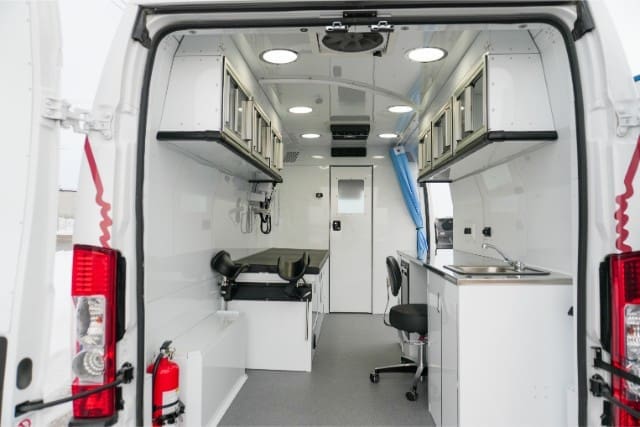
Lighting might not be the first thing you think about when planning your mobile clinic, but it’s a game-changer—especially here in Illinois.
Adding extra lighting inside or outside the unit typically costs about $1,500. That might sound like a simple upgrade, but in real-world use, it makes a big difference for both safety and how your team works.
Why does extra lighting matter for your mobile health clinic in Illinois?
Long winter days: In Illinois, it gets dark early during fall and winter—sometimes before 5 PM. Extra lighting helps you keep going after daylight ends.
Safety at night: Good exterior lighting helps patients see where they’re going and keeps your staff safer when loading, unloading, or working outside the vehicle.
Better visibility inside: If your team is doing exams, paperwork, or working with detailed tools, better lighting can reduce eye strain and help avoid mistakes.
It’s a small investment, but if your clinic will operate in the early mornings, evenings, or during cloudy Midwest days (and let’s be honest, we get plenty), extra lighting can keep things running smoothly.
Individual seating options: $1,500
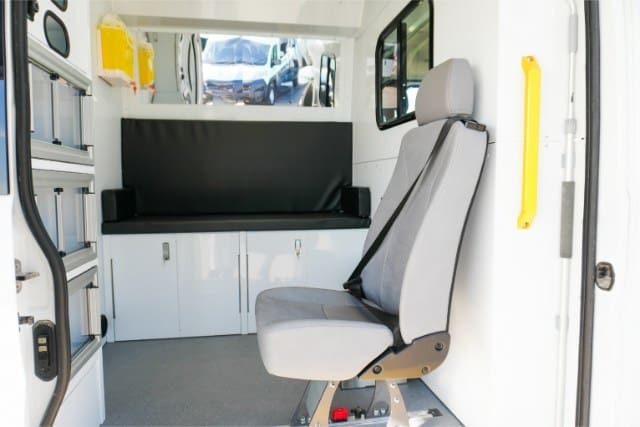
Spending $1,500 on individual seating might not seem exciting, but it can seriously improve the way your mobile clinic works, especially in busy Illinois communities.
Instead of one long bench or shared seating, individual seats give each person their own space. That small change can make a big impact.
Why this matters in Illinois:
Patient comfort: Whether you’re in a city like Rockford or a rural town in southern Illinois, people appreciate personal space—especially in a medical setting. It helps them feel more respected and at ease.
Better traffic flow: Individual seats make it easier to manage wait times and keep things moving inside the clinic. You’ll know who’s next and avoid crowding.
Great for outreach programs: If you’re visiting schools, shelters, or senior centers, flexible seating options let you adjust for different group sizes and needs.
This $1,500 feature helps your space feel more professional, calm, and organized—which goes a long way when you’re serving communities that may already feel anxious about getting care.
Administration fees: $1,000
Here’s a cost that’s easy to miss—administration fees. On average, you’ll want to set aside about $1,000 for this.
Now, what’s this fee actually for? It covers the behind-the-scenes work that gets your mobile clinic from a concept to something that can actually hit the road in Illinois.
Here’s what it covers:
Planning and coordination: From design meetings to layout approvals, a lot of time goes into making sure your unit fits your goals.
Documentation and records: Contracts, drawings, order summaries, shipping docs—there are a lot of details to keep track of.
Communication with multiple teams: Building a mobile clinic takes input from sales, engineering, production, and more. Admin teams help tie it all together.
When you’re planning your budget, it’s smart to expect this upfront. That way, there are no surprises.
Delivery fees: Around $6,500
Once your mobile clinic is built, there’s one last step—getting it to you. And that’s where delivery fees come in. On average, this cost is around $6,500.
Now, that might feel like a big number just to move something from point A to point B. But delivering a full-sized medical vehicle across the country is no small job.
Illinois is a big state. Whether your organization is in Chicago, Peoria, Springfield, or a small rural town, the cost to deliver the unit can vary based on distance, route, and how easy (or tricky) it is to access your location.
So, while it’s not the flashiest line item, delivery fees are important to include in your budget.
Taxes
When you’re budgeting for a mobile clinic in Illinois, it’s important to factor in sales tax, as it can significantly impact your total cost.
How does Illinois sales tax work?
State sales tax: Illinois imposes a base sales tax rate of 6.25% on general merchandise, which includes vehicles like mobile clinics.
Local taxes: Depending on your location within Illinois, additional local taxes may apply.
For example:
- In Chicago, there’s an additional 1.25% city tax, bringing the total to 7.5%.
- Other counties may have varying rates, typically ranging from 0.25% to 0.75%.
Example calculation:
Let’s say you’re purchasing a mobile clinic priced at $125,000.
Here’s how the sales tax could add up:
State tax (6.25%): $125,000 × 0.0625 = $7,812.50
Local tax: This varies by location.
For instance:
In Chicago (1.25% city tax):
- $125,000 × 0.0125 = $1,562.50
- Total tax in Chicago: $7,812.50 (state) + $1,562.50 (city) = $9,375
In a county with a 0.5% local tax:
- $125,000 × 0.005 = $625
- Total tax in this county: $7,812.50 (state) + $625 (local) = $8,437.50
Deposit: $50,000
Once you decide to move forward with a mobile clinic, the first step is a $50,000 deposit. This is standard and helps us get things moving on your build.
We get it—it’s a big number. But here’s what that deposit actually does for you:
It locks in your spot in the production queue: We build mobile clinics one at a time, custom to your needs. This deposit secures your place in our production schedule so we can start planning right away.
It keeps things moving: The sooner we start, the sooner your mobile clinic gets on the road and into the areas of Illinois where people need healthcare.
Get a customized quote for your mobile clinic in Illinois
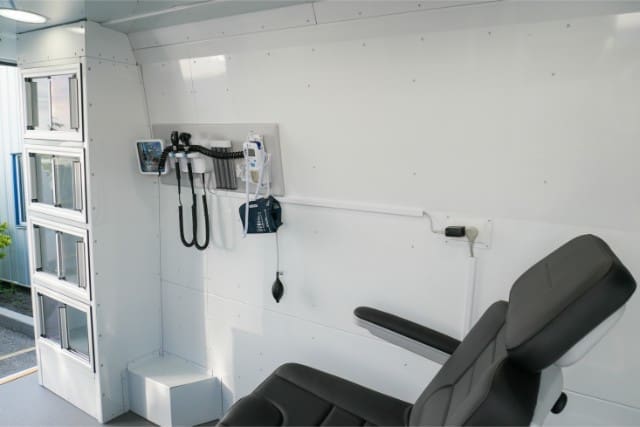
You came to this article because you’re trying to solve a real challenge—how to bring healthcare to more people in Illinois using a mobile clinic. You needed answers about cost, what affects it, and how to make sure you’re making the right call.
Here’s a quick recap of what you learned:
- A mobile clinic in Illinois typically costs between $125,000 and $225,000
- Features like awnings, security bars, medical equipment, lighting, and custom seating all affect the final price
- Extra costs like taxes, delivery fees, deposits, and admin fees should be part of your plan
At AVAN Mobility, we specialize in manufacturing mobile medical units that help organizations like yours close healthcare gaps all over the country. We’ve helped community clinics, nonprofits, public health teams, and more design and deliver vehicles that make a difference—right where people need them.
Our team is here to guide you through the process with honesty, care, and experience. Because to us, this work isn’t about selling vehicles—it’s about helping you save lives.
Have any questions? Click the button below to chat with a mobility expert—we’d love to hear about your goals and see how we can help.
If you’re not quite ready to talk yet, we’ve got a few other helpful resources you can check out to keep learning.
Start by checking out part one of our five-part guide on mobile clinics. This will guide you through most things you need to know about them.
After that, check out our article on some of the pitfalls to avoid when buying a mobile clinic. If you prefer to learn by watching instead, check out the video below.



